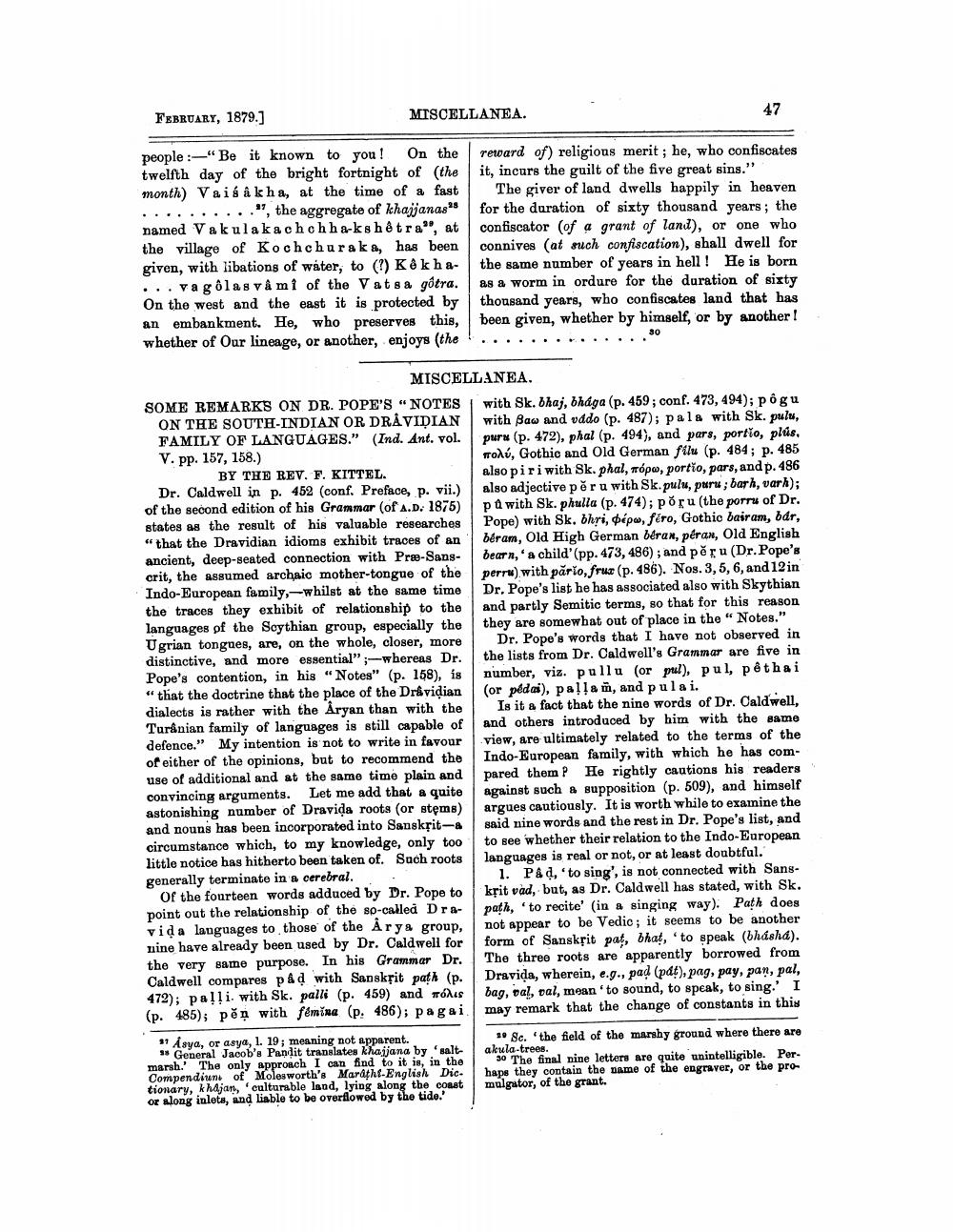________________
FEBRUARY, 1879.]
MISCELLANEA.
people :-"Be it known to you! On the twelfth day of the bright fortnight of the month) Vais â kha, at the time of a fast ..........", the aggregate of khajjanas's named Vakulakachchha-kshetra", at the village of Kochchuraka, has been given, with libations of water, to (?) Kék ha... va g ôlas vâ mi of the Vatsa gôtra. On the west and the east it is protected by an embankment. He, who preserves this, whether of Our lineage, or another, enjoys (the
reward of) religious merit; he, who confiscates it, incurs the guilt of the five great sins."
The giver of land dwells happily in heaven for the duration of sixty thousand years; the confiscator (of a grant of land), or one who connives (at such confiscation), shall dwell for the same number of years in hell! He is born as a worm in ordure for the duration of sixty thousand years, who confiscates land that has been given, whether by himself, or by another!
MISCELLANEA. SOME REMARKS ON DR. POPE'S NOTES with Sk. bhaj, bhaga (p. 459; conf. 473,494); pôgu
ON THE SOUTH INDIAN OR DRÅVIDIAN with Baw and vddo (p. 487); pala with Sk. pulu, FAMILY OF LANGUAGES." (Ind. Ant. vol. puru (p. 472), phal (p. 494), and pars, portio, plus, V. pp. 157, 158.)
modú, Gothic and Old German filu (p. 484; p. 485 BY THE REV. F. KITTEL.
also piri with Sk. phal, Trópw, portio, pars, and p. 486 Dr. Caldwell in p. 452 (conf. Preface, p. vii.) also adjective pěr u with Sk.pulu, puru; barh, varh); of the second edition of his Grammar (of A.D. 1875) pd with Sk. phulla (p. 474); poru(the porru of Dr. states as the result of his valuable researches Pope) with Sk, bhri, pépw, firo, Gothic bairam, odr, "that the Dravidian idioms exhibit traces of an béram, Old High German béran, pêrax, Old English ancient, deep-seated connection with Præ-Sang- bearn,' a child' (pp. 473, 486); and pěru (Dr. Pope's crit, the assumed archaic mother-tongue of the perrw).with părio, frut (p. 486). Nos. 3, 5, 6, and 12 in Indo-European family, whilst at the same time Dr. Pope's list he has associated also with Skythian the traces they exhibit of relationship to the and partly Semitic terms, so that for this reason languages of the Scythian group, especially the they are somewhat out of place in the “ Notes." Ugrian tongues, are, on the whole, closer, more Dr. Pope's words that I have not observed in distinctive, and more essential" ;-whereas Dr. the lists from Dr. Caldwell's Grammar are five in Pope's contention, in his "Notes" (p. 158), 18 number, viz. pullu (or pril), pul, pethai " that the doctrine that the place of the Dravidian (or pédas), pallam, and pula i. dialects is rather with the Aryan than with the Is it a fact that the nine words of Dr. Caldwell, Turânian family of languages is still capable of and others introduced by him with the same defence." My intention is not to write in favour view, are ultimately related to the terms of the of either of the opinions, but to recommend the Indo-European family, with which he has comuse of additional and at the same time plain and pared them P He rightly cautions his readers convincing arguments. Let me add that a quite against such a supposition (p. 509), and himself astonishing number of Dravida roots (or stems) argues cautiously. It is worth while to examine the and nouns has been incorporated into Sanskrit- said nine words and the rest in Dr. Pope's list, and circumstance which, to my knowledge, only too to see whether their relation to the Indo-European little notice has hitherto been taken of. Such roots languages is real or not, or at least doubtful. generally terminate in a cerebral .
1. Påd, 'to sing', is not connected with SansOf the fourteen words adduced by Dr. Pope to krit vad, but, as Dr. Caldwell has stated, with Sk. point out the relationship of the so-called Dra- path, 'to recite' (in a singing way), Path does vida languages to those of the Arya group, not appear to be Vedic; it seems to be another nine have already been used by Dr. Caldwell for form of Sanskrit pat, bhat, 'to speak (bhashd). the very same purpose. In his Grammar Dr. The three roots are apparently borrowed from Caldwell compares på with Sanskrit path (p. Dravida, wherein, e.g., pad (pat), pag, pay, pan, pal, 472); palli. with Sk. palli (p. 459) and Tods bag, val, val, mean'to sound, to speak, to sing.' I (p. 485); pěn with femina (p: 486); pagai may remark that the change of constants in this » Asya, or asya, 1. 19; meaning not apparent.
** 8c. the field of the marshy ground where there are » General Jacob's Pandit translates khajjana by 'salt! akula-trees. marsh.' The only approach I can find to it is, in the 30 The final nine letters are quite unintelligible. Per Compendium of Molesworth's Marathi-English Dic. hape they contain the name of the engraver, or the protionary, khajan, culturable land, lying along the const mulgator, of the grant. or along inlets, and liable to be overflowed by the tide.'




